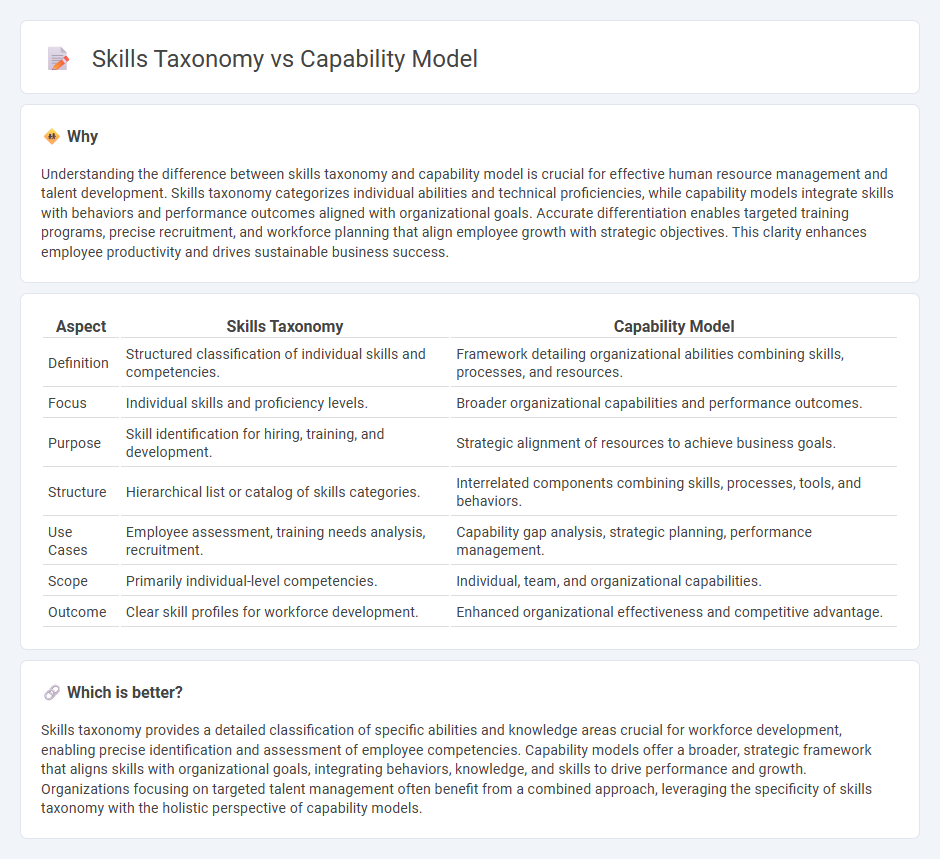
Skills taxonomy systematically categorizes individual skills and competencies within an organization, enabling precise assessment and targeted development of employee abilities. Capability models integrate these skills with organizational processes and behaviors to reflect overall performance potential and strategic alignment. Explore how these frameworks enhance talent management and drive business success.
Why it is important
Understanding the difference between skills taxonomy and capability model is crucial for effective human resource management and talent development. Skills taxonomy categorizes individual abilities and technical proficiencies, while capability models integrate skills with behaviors and performance outcomes aligned with organizational goals. Accurate differentiation enables targeted training programs, precise recruitment, and workforce planning that align employee growth with strategic objectives. This clarity enhances employee productivity and drives sustainable business success.
Comparison Table
| Aspect | Skills Taxonomy | Capability Model |
|---|---|---|
| Definition | Structured classification of individual skills and competencies. | Framework detailing organizational abilities combining skills, processes, and resources. |
| Focus | Individual skills and proficiency levels. | Broader organizational capabilities and performance outcomes. |
| Purpose | Skill identification for hiring, training, and development. | Strategic alignment of resources to achieve business goals. |
| Structure | Hierarchical list or catalog of skills categories. | Interrelated components combining skills, processes, tools, and behaviors. |
| Use Cases | Employee assessment, training needs analysis, recruitment. | Capability gap analysis, strategic planning, performance management. |
| Scope | Primarily individual-level competencies. | Individual, team, and organizational capabilities. |
| Outcome | Clear skill profiles for workforce development. | Enhanced organizational effectiveness and competitive advantage. |
Which is better?
Skills taxonomy provides a detailed classification of specific abilities and knowledge areas crucial for workforce development, enabling precise identification and assessment of employee competencies. Capability models offer a broader, strategic framework that aligns skills with organizational goals, integrating behaviors, knowledge, and skills to drive performance and growth. Organizations focusing on targeted talent management often benefit from a combined approach, leveraging the specificity of skills taxonomy with the holistic perspective of capability models.
Connection
Skills taxonomy organizes and categorizes individual competencies required for various job roles, providing a structured vocabulary for HR functions. Capability models leverage this taxonomy to map these competencies into broader organizational abilities that drive performance and strategic goals. Together, they enable precise workforce planning, targeted development, and effective talent management within human resources.
Key Terms
Competencies
Capability models outline the overarching abilities and behaviors required for effective job performance, integrating knowledge, skills, and attitudes across roles. Skills taxonomy categorizes specific proficiencies and technical skills within an organization, providing a detailed inventory of capabilities. Explore the distinctions between these frameworks to enhance workforce development strategies.
Proficiency Levels
Capability models define organizational competencies by grouping related skills and knowledge, emphasizing proficiency levels that range from basic to expert to measure performance and growth. Skills taxonomies categorize individual skills systematically, often using detailed proficiency scales to assess employee expertise and guide development plans. Explore more to understand how proficiency levels impact talent management and organizational efficiency.
Role Mapping
Capability models define the comprehensive abilities and behaviors required for effective role performance, while skills taxonomies categorize specific competencies needed within those roles. Role mapping leverages capability models to align job functions with organizational goals and uses skills taxonomies to pinpoint precise skill gaps for targeted development. Explore how integrating both approaches enhances workforce planning and talent management strategies.
Source and External Links
Business Capability Model: A Guide to Benefits and Best Practices - This guide outlines the process of creating a business capability model, which aligns operational functions with strategic objectives.
Talent Development Capability Model - The Talent Development Capability Model from ATD provides a framework for guiding talent development professionals with 23 key capabilities.
Business Capability Models Explained: A Comprehensive Guide - This comprehensive guide explains how business capability models describe the capabilities needed to execute a business model or mission.
 dowidth.com
dowidth.com